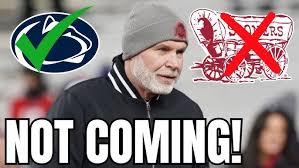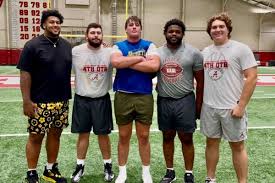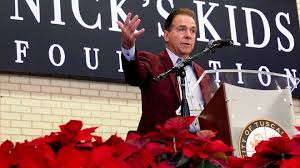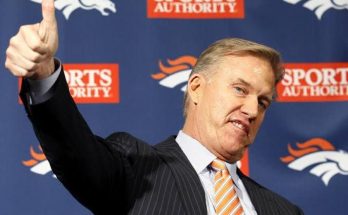OU Football: Jim Knowles Tells the Oklahoma Sooners “No!”
In a world of constant change in college football, few decisions have created as much buzz as Jim Knowles’ rejection of an offer to become the next defensive coordinator for the Oklahoma Sooners. As a defensive mastermind, Knowles has already made waves with his impressive track record at Oklahoma State, followed by a high-profile stint at Ohio State. When rumors started circulating that the Sooners were eyeing Knowles for their defensive coordinator position, many believed it would be a homecoming for the coach and a turning point for a defense that had struggled to match the dominance of their high-powered offense.
However, despite the appeal of leading a historic program like Oklahoma, Jim Knowles has made it clear that he will not be joining the Sooners’ coaching staff. Instead, he has chosen to stay with his current program or explore different opportunities. This rejection carries substantial weight for both Oklahoma and the broader college football community. Let’s dive into the reasons behind this surprising decision and what it means for both the Oklahoma Sooners and Jim Knowles.
The Background: A Brief Overview of Jim Knowles’ Career
Before we can understand Knowles’ decision to turn down Oklahoma, it’s essential to examine the coach’s career trajectory. Jim Knowles began his coaching career in the late 1980s, spending time in various roles at Cornell University before moving to Duke University, where he first made his name as a respected defensive coach. His big break came when he moved to Oklahoma State, where he revitalized the defense and earned recognition for building one of the most aggressive and effective units in the nation.
After four years with Oklahoma State, Knowles moved to Ohio State, where his reputation only grew stronger. During his time as the defensive coordinator for the Buckeyes, Knowles helped turn around a defense that had been underperforming in the years prior. His 2022 defense ranked among the top units in college football, and Ohio State’s defense quickly became a feared group in the Big Ten and nationally. His ability to develop talent and implement complex schemes made him a prime candidate for many other schools, including the Oklahoma Sooners.
Why Did Jim Knowles Say “No” to Oklahoma?
There are several key reasons why Jim Knowles ultimately turned down Oklahoma’s offer. These reasons involve both professional and personal considerations, with a few critical factors standing out.
1. The Ohio State Commitment
At the core of Knowles’ decision is his strong commitment to Ohio State. When he joined the Buckeyes, Knowles was tasked with reshaping the defense and restoring the program’s once-dominant defensive reputation. With his work starting to show tangible results, it would be hard for any coach to walk away from a program that is on the brink of greatness. The Ohio State defense has improved dramatically since his arrival, and Knowles has become a key component of the team’s success. Turning down Oklahoma could have been an indication that he sees the job at Ohio State as unfinished, especially after losing in the College Football Playoff to Georgia in a heartbreaking game.
Moreover, Knowles has had the chance to work with some of the brightest defensive minds in college football, particularly under head coach Ryan Day. The familiarity with the team, the staff, and the program’s overall culture likely played a significant role in his decision to stay.
2. The Challenge of Building a Legacy at Ohio State
Another reason Knowles may have passed on Oklahoma is the challenge of building a legacy at a program like Ohio State. While Oklahoma has a rich history and a proven track record of success, Ohio State is often considered one of the top-tier programs in the country. The opportunity to be part of a defense that could dominate in both the Big Ten and on a national level is a chance few coaches would pass up.
Oklahoma, on the other hand, has had issues on defense in recent years, and rebuilding a program’s defense from the ground up could have been a daunting task. Knowles might have seen the job at Oklahoma as a riskier proposition compared to continuing his success with Ohio State, where his job was more secure, and the potential for winning a national title felt within reach.
3. The Appeal of Ohio State’s Resources
At Ohio State, Knowles has access to some of the best resources in the country. The Buckeyes boast world-class facilities, top-tier recruiting, and a massive fanbase that demands success. The program’s financial backing is also second to none, and Knowles is likely aware that the Buckeyes have the means to make his job as comfortable and successful as possible.
In contrast, Oklahoma, though a prestigious program, has faced some uncertainty with its future in the Big 12 and has undergone significant changes with the coaching staff. The Sooners’ defense has been criticized for not living up to expectations, and Knowles would have had to step into a situation where expectations were sky-high. The uncertainty surrounding Oklahoma’s move to the SEC, where competition will undoubtedly be more difficult, may have played a role in his decision to stay in familiar and stable surroundings at Ohio State.
4. Family and Personal Considerations
Coaching at the highest levels of college football is a demanding job, and many decisions are influenced by personal considerations. Jim Knowles has been in the coaching profession for over 30 years, and by now, he is no stranger to the long hours and immense pressure that come with the job. His decision to stay with Ohio State could also be influenced by personal reasons, including family stability and his comfort with the Columbus, Ohio, area.
Being a head coach or coordinator at a high-profile program like Oklahoma requires constant travel, recruitment, and media scrutiny. Knowles might have determined that staying at Ohio State offered the right balance of professional success and personal satisfaction, ensuring that both his career and personal life continued to thrive.
5. Oklahoma’s Current State of the Program
Finally, the state of Oklahoma’s football program might have played a crucial role in Knowles’ decision. While the Sooners have been a perennial powerhouse in college football, the recent years have been rocky for the program. From Lincoln Riley’s sudden departure to a tumultuous transition under new head coach Brent Venables, Oklahoma is in a period of transition.
Venables’ tenure is still in its early stages, and while his defensive pedigree is strong, the Sooners have struggled to regain their elite status. Knowles may have seen this as a sign that Oklahoma was not yet the stable, championship-caliber team that it once was. Without the guarantee of immediate success, the decision to join the Sooners would have been a risky move for a coach who has already proven himself at a top-tier program like Ohio State.
What’s Next for Oklahoma?
With Knowles turning down the Sooners, Oklahoma now finds itself in the market for a new defensive coordinator. The search is expected to be high-profile, with the program needing to find a coach who can resurrect a defense that has been underperforming in recent years. Oklahoma’s next defensive coordinator will have big shoes to fill, and the pressure to perform immediately will be immense.
Names like Brent Venables himself have been floated as possible candidates to step in and oversee the defense, but the Sooners will likely explore a variety of options. Many believe that Oklahoma needs someone with experience in turning around defenses and someone who can bring the intensity and success that Knowles would have provided.
Conclusion
Jim Knowles’ decision to say “no” to Oklahoma is a significant one. It speaks volumes about his confidence in the Ohio State program and his belief in the long-term success of the Buckeyes. For the Sooners, it’s back to the drawing board, and their search for the right defensive coordinator will continue. This decision could have major implications for both programs as they move forward, with Ohio State continuing to build on its defensive dominance and Oklahoma trying to find the right pieces to put their defense back together.



